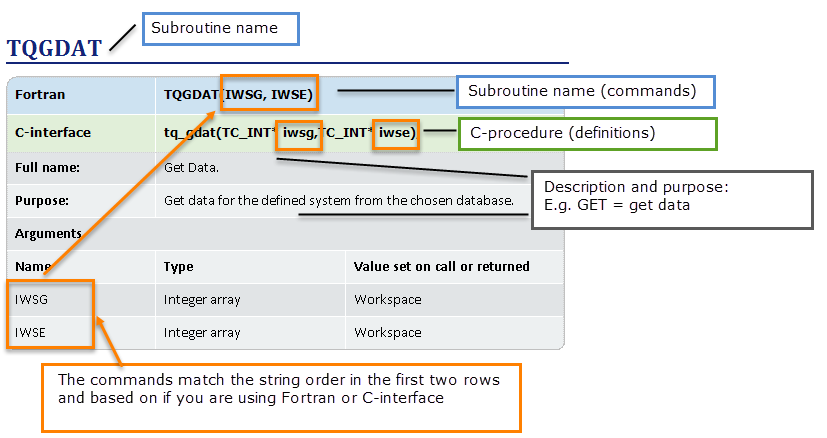TQIPS_INIT_BRANCH
| Fortran |
TQIPS_INIT_BRANCH(TISCOND, TISCNST, PISCOND, PISCNST, IDEPEL, IDISCRT, NSTEP, IPHSTA, T, TMIN, TMAX, P, PMIN, PMAX, RMEMFR, PHAMNT,XMIN, XMAX, IBRANCH, IERR IWSG, IWSE |
|
|---|---|---|
| C-interface |
tq_ips_init_branch(TC_BOOL t_is_condition, TC_BOOL t_is_constant, TC_BOOL p_is_condition, TC_BOOL p_is_constant, TC_BOOL* independent_elements,TC_INT dicretization_type, TC_INT nr_of_steps, TC_INT* state_of_phases, TC_FLOAT t, TC_FLOAT tmin, TC_FLOAT tmax,TC_FLOAT p,TC_FLOAT pmin, TC_FLOAT pmax, TC_FLOAT memory_fraction, TC_FLOAT* amount_of_phases, TC_FLOAT* xmin, TC_FLOAT* xmax, TC_INT* branch_nr, TC_INT* err, TC_INT* iwsg, TC_INT* iwse) |
|
|
Full name: |
Initiate a branch of the adaptive interpolation scheme. |
|
|
Purpose: |
Initiates a branch of the interpolation scheme with a set of conditions, phases and values to be interpolated. |
|
|
Comments: |
The size of the arrays IDEPEL, XMIN and XMAX are defined as the number of all components supplied by TQGNC must be provided in the same order as supplied by TQGCOM.Composition conditions are set as the normalized number of moles for each component (N(c) =value).The size of the arrays IPHSTA and PHAMNT are defined as the number of all phases supplied by TQGNP must be provided in the same order as supplied by TQGPN.The allocation of memory to each branch is performed at the first time values are retrieved using TQIPS_GET_VALUE, therefore some considerations must be made when using several branches in order to allocate the same amount of memory to each branch. |
|
|
Arguments |
||
|
Name |
Type |
Value set on call or returned |
|
TISCOND |
Logical |
Set to TRUE if temperature is a condition in this branch. |
|
TISCNST |
Logical |
Set to TRUE if temperature is constant in this branch. |
|
PISCOND |
Logical |
Set to TRUE if pressure is a condition in this branch. |
|
PISCNST |
Logical |
Set to TRUE if pressure is constant in this branch. |
|
IDEPEL |
Logical array |
Set to TRUE for each element for which conditions are present. |
|
IDISCRT |
Integer |
Indicates the type of discretization where: 1=linear2=logarithmic |
|
NSTEP |
Integer |
Set to the logarithm (10 base) number of steps to be used to interpolate in the temperature / pressure / composition space. |
|
IPHSTA |
Integer array |
Set to the status for the phases in this branch, where: 1=ENTERED, 2=SUSPENDED, 3=DORMANT, 4=FIXED |
|
T |
Double precision
|
Set to temperature if temperature is a condition, otherwise used as starting value. |
|
TMIN |
Double precision |
Set to lower limit of temperature range. |
|
TMAX |
Double precision |
Set to upper limit of temperature range. |
|
P |
Double precision |
Set to pressure if pressure is a condition, otherwise used as starting value. |
|
PMIN |
Double precision |
Set to lower limit of pressure range. |
|
PMAX |
Double Precision |
Set to upper limit of pressure range. |
|
RMEMFR |
Double precision |
Set to the fraction of the amount of free physical memory to be allocated to the interpolation scheme for this branch (value < 1.0). If a value larger than 1.0 if set, it is interpreted as the number of megabytes allocated to the branch. |
|
PHAMNT |
Double precision array |
Set to the amount of the phase if defined as a fixed phase with IPHSTA. |
|
XMIN |
Double precision array |
Set to the lower limit of the composition range of each component. |
|
XMAX |
Double precision array |
Set to the upper limit of the composition range of each component. |
|
IBRANCH |
Integer |
Set to branch number for which the variable in STRING is to be interpolated. |
|
IERR |
Integer |
Returns error code. |
|
IWSG |
Integer array |
Workspace. |
|
IWSE |
Integer array |
Workspace |
Note the following conventions to distinguish between the programming languages.
- Routines starting with TQXXX, for example, TQGDAT, are in the Fortran interface
- Routines starting with tq_xxxx, for example tq_gdat, are in the C-interface.
- In Fortran, all routines are subroutines and do not return any values except where explicitly declared as functions.
- All the C procedures are declared as void and do not return any values except where explicitly otherwise declared.
An example of how to read the subroutine definitions.
